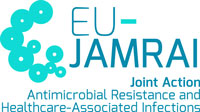Step by step guide for the implementation and assessment of Workshops
Workshops are structured, interactive group sessions focused on hands-on practice, collaborative activities, and problem-solving to develop specific skills or explore complex AMR/AMS topics in depth. They emphasize active participation and application of knowledge, moving beyond passive information reception.

Planning a Workshops
The following steps should be taken into consideration when planning a workshop on AMR/AMS:
- Needs Assessment & Objective Setting: Identify specific AMR/AMS knowledge gaps or skill needs of the target audience (e.g., based on local prescribing data or identified challenges as in Chetty et al. 2024). Define clear, measurable learning objectives.
- Content Design & Material Development: Develop content that is relevant, evidence-based, and practical. Incorporate diverse interactive elements such as case studies (MacDougall et al. 2017, Chetty et al. 2024), analysis of local prescribing data (Jones et al. 2017), role-playing, group discussions, and problem-solving exercises. Prepare necessary materials (handouts, guidelines, case vignettes, data summaries).
- Logistics and Promotion: Plan logistics (venue/virtual platform, timing, duration). Promote the workshop to the target audience, highlighting benefits. Consider a pre-workshop task to encourage reflection (Chetty et al. 2024).
- Facilitation: Conduct the workshop using skilled facilitators who can encourage participation, manage group dynamics, and guide learning. Allocate participants to small, often interprofessional groups for collaborative tasks (Chetty et al. 2024, MacDougall et al. 2017).
- Action Planning: Dedicate time for participants/groups to develop concrete action plans for implementing learned concepts in their practice or workplace (Jones et al. 2017).
- Feedback and Summary: Conclude with a summary of key learnings and solicit feedback on the workshop itself.

Defining roles in a Workshops
Clearly defining roles ensures smooth collaboration, active engagement, and meaningful learning, creating a supportive environment where everyone can contribute effectively.
- Facilitator’s role: Guide activities, stimulate critical thinking and discussion, provide expert input where needed, ensure all voices are heard, manage time effectively, and create a psychologically safe and supportive learning environment conducive to sharing and collaboration.
- Participant’s role: Actively engage in all activities, contribute to group discussions and problem-solving, share experiences and perspectives, reflect on current practices, develop actionable plans, and commit to applying learnings.

Assessing a Workshops
Assessment is essential for understanding learning, skill development, and the practical impact of an educational methodology, helping identify successes and areas for improvement.
Methods
- Pre- and post-workshop knowledge and attitude assessments (Jha et al. 2020, MacDougall et al. 2017).
- Evaluation of action plans developed by participants/groups.
- Observation of skills demonstrated during interactive exercises or case discussions.
- Participant feedback on workshop content, delivery, and perceived impact (Chetty et al. 2024, Jones et al. 2017).
- Follow-up assessments to measure behavioral change or implementation of action plans in practice.
Tools
Validated questionnaires for knowledge and attitudes (e.g., MacDougall et al. 2017), structured feedback forms, rubrics for evaluating action plans or case presentations,

Suggested Workshops prototype
Interprofessional AMS Action Planning Workshop
Target Audience: Health Managers, Prescribers, Dispensers, Clinical Profiles, and potentially Legislators/Authorities or Educators depending on the specific focus. (Workshops are widely supported and adaptable; interprofessional workshops are highlighted by Chetty et al. 2024 and MacDougall et al. 2017).
Learning Objectives:
- collaboratively identify key local AMR/AMS challenges within their institution or region.
- Develop shared understanding and agreement on priority areas for AMS intervention.
- Co-create a feasible, evidence-based action plan for a specific AMS initiative (e.g., improving adherence to a prescribing guideline, implementing an IV-to-oral switch protocol)
Curriculum/Activities:
- Part 1 (Pre-workshop online module – optional but recommended as per MacDougall et al. 2017): Basic theory on AMS, local AMR data review.
- Part 2 (Workshop):
- Review of local AMR data and identification of specific prescribing/stewardship issues (Jones et al. 2017).
- Interactive sessions focusing on case vignettes and problem-solving in small interprofessional groups (doctors, pharmacists, nurses, managers) (Chetty et al. 2024).
- Facilitated discussion on barriers and enablers to good stewardship practices.
- Guided development of a SMART (Specific, Measurable, Achievable, Relevant, Time-bound) action plan for a chosen AMS intervention, including roles and responsibilities.
- Presentation of action plans by groups for peer feedback.
Evaluation of the Prototype’s Effectiveness:
- Immediate feedback via workshop evaluation forms (Jones et al. 2017).
- Assessment of the quality and feasibility of the developed action plans.
- Follow-up (e.g., 3-6 months) to assess the extent of implementation of the action plans and any reported changes in practice or AMS metrics (Kirkpatrick Levels 3 & 4).
- Interviews or focus groups with participants to explore perceived impact and barriers to implementation (Jones et al. 2017).
References
- Chetty, S., Swe-Han, K. S., Mahabeer, Y., Pillay, A., & Essack, S. Y. (2024). Interprofessional education in antimicrobial stewardship, a collaborat ive effort. JAC-Antimicrobial Resistance, 6(2). Crossref. https://doi.org/10.1093/jacamr/dlae054
- Jha, N., Shankar, P. R., & Bhandary, S. (2020). Knowledge, attitude and practice immediately before and following a th ree-day workshop on ‘Strategies for reducing antimicrobial resistance and promoting rational use of antimicrobials.’ Research Square. Crossref. https://doi.org/10.21203/rs.3.rs-43623/v1
- Jones, L. F., Hawking, M. K. D., Owens, R., Lecky, D., Francis, N. A., Butler, C., Gal, M., & McNulty, C. A. M. (2017). An evaluation of the TARGET (Treat Antibiotics Responsibly; Guidance, Education, Tools) Antibiotics Toolkit to improve antimicrobial steward ship in primary care—Is it fit for purpose? Family Practice, 35(4), 461–467. Crossref. https://doi.org/10.1093/fampra/cmx131
- MacDougall, C., Schwartz, B. S., Kim, L., Nanamori, M., Shekarchian, S., & Chin-Hong, P. V. (2017). An Interprofessional Curriculum on Antimicrobial Stewardship Improves Knowledge and Attitudes Toward Appropriate Antimicrobial Use and Collaboration. Open Forum Infectious Diseases, 4(1). Crossref. https://doi.org/10.1093/ofid/ofw225
- Pulcini, C., & Gyssens, I. C. (2013). How to educate prescribers in antimicrobial stewardship practices. Virulence, 4(2), 192–202. Crossref. https://doi.org/10.4161/viru.23706
- Rocha-Pereira, N., Castro Sanchez, E., & Nathwani, D. (2017). How Can Multi-Professional Education Support Better Stewardship? Infectious Disease Reports, 9(1), 6917. Crossref. https://doi.org/10.4081/idr.2017.6917
- Rogers Van Katwyk, S., Jones, S. L., & Hoffman, S. J. (2018). Mapping educational opportunities for healthcare workers on antimicrob ial resistance and stewardship around the world. Human Resources for Health, 16(1). Crossref. https://doi.org/10.1186/s12960-018-0270-3.
